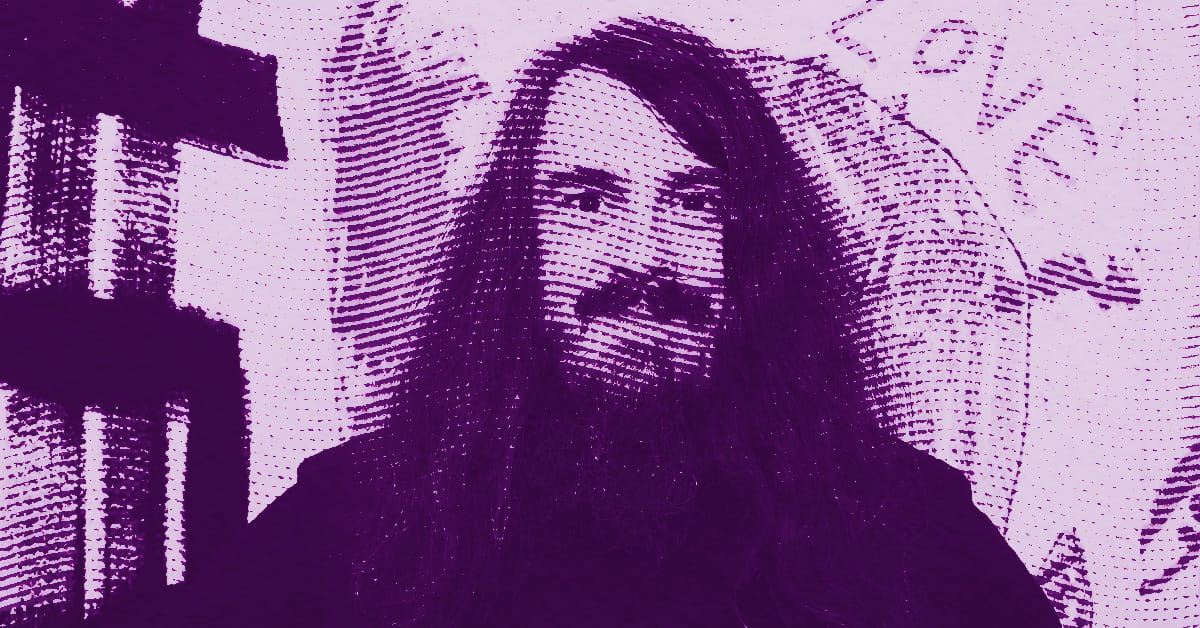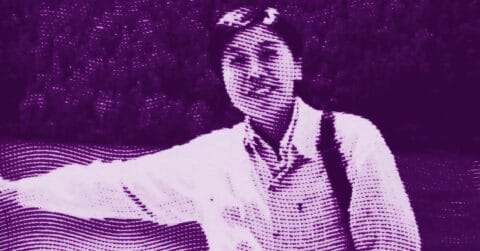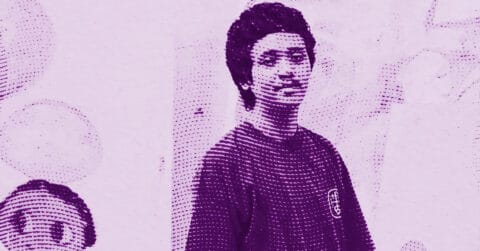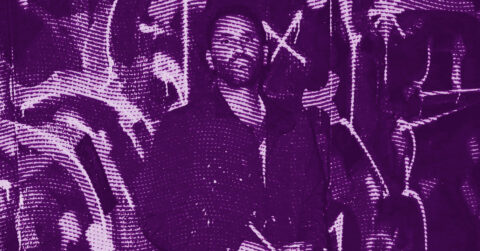Listen to me carefully, you bunch of snobs. Here we face one of the most disconcerting and necessary artistic phenomena of our time: Jonathan Meese, this German born in Tokyo in 1970, who for more than two decades has been tormenting our aesthetic certainties with admirable consistency. In his Berlin bunker-studio, surrounded by his mother Brigitte who plays the drill sergeant of creative order, Meese manufactures an art that stubbornly refuses to be tamed by our usual interpretive grids. His pictorial universe, populated by decomposed historical figures and pop references massacred with a furious brushstroke, constitutes a visual experience that brutally confronts us with our own conceptual limits.
Meese’s work is not content with occupying museum space with the casual arrogance of a luxury squatter. It imposes its presence through chromatic and formal violence that stuns as much as it repulses, creating that particular sensation of being trapped in a technicolor nightmare whose outcome stubbornly remains invisible. His canvases, real battlefields where colored pastes and grimacing figures clash, bear witness to an expressive urgency that runs through the history of German art like a blade heated to white-hot. This urgency finds its roots in a complex relationship to power, authority, and above all to this “Dictatorship of Art” that he proclaims with the fervor of a hallucinated evangelist.
The unconscious at work: Jonathan Meese and the psychoanalytic machine
Jonathan Meese’s approach reveals disturbing correspondences with the mechanisms of the Freudian unconscious, particularly in his ability to transform collective traumas into pictorial matter. Contemporary art, flirting with abstraction or offering conceptual works, invites each person to project their own experiences, fears, and desires onto the work [1], and Meese pushes this logic to its most extreme limits. His paintings function as projection screens where our deepest anxieties concerning authority, violence, and submission crystallize.
The artist develops a creative process that irresistibly evokes the work of condensation and displacement at work in the formation of dreams. His historical figures, Hitler, Napoleon, and Wagner, undergo plastic transformations that strip them of their historical gravity to turn them into grotesque, almost clownish figures. This operation of symbolic devaluation recalls the psychic defense mechanisms by which the individual neutralizes what threatens him. Meese does not destroy these figures; he makes them ridiculous, emptying them of their phantasmatic power through the excess of their very representation.
The obsessive presence of his mother in his creative process is a crucial element for understanding the psychoanalytic dimension of his work. Brigitte Meese is not only his assistant, she embodies a maternal authority that structures and channels the artist’s destructive impulses. This family configuration evokes Freudian analyses of sublimation, a process by which aggressive drives find a socially acceptable outlet in artistic creation. Meese himself acknowledges that his mother “brings order” to his life and studio, playing the role of a benevolent superego that allows the artist to give form to his obsessions without sinking into self-destruction.
The complex relationship Meese maintains with ideology is also illuminated from a psychoanalytic perspective. His “Dictatorship of Art” functions as a compromise formation, allowing him to express fantasies of omnipotence while defusing them through their openly delusional nature. The artist projects his dominating drives onto art itself, creating a theoretical fiction that enables him to avoid direct political engagement. This avoidance strategy reveals a particularly sophisticated psychic structure, capable of transforming anxiety into creative energy while maintaining a critical distance from his own obsessions.
The analysis of his self-portraits also reveals an assumed narcissistic dimension that recalls Freud’s descriptions of primary narcissism. Meese constantly depicts himself in his works, but always with distorted, grotesque features that reflect an ambivalent relationship with his own image. This compulsive self-representation evokes the Fort-Da described by Freud, the repetitive game through which the child symbolically masters what escapes him. Meese disappears and reappears in his canvases as if trying to control his own existence through the repetition of his image.
The pulsional dimension of his work also manifests in his brutal painting technique, where paint is pressed directly from the tube onto the canvas, avoiding any mediation by the traditional brush. This immediacy of gesture evokes the direct expression of the libido, without the usual sublimations of classical artistic practice. Meese paints as one releases tension, in the urgency of a relief that cannot be deferred.
The recurring obsession with masculine figures of power, dictators, emperors, and Wagnerian heroes, reveals a fascination with paternal authority that the artist both appropriates and deconstructs simultaneously. These characters function as substitutes for the symbolic father, whom he can both venerate and destroy without risking real consequences. Psychoanalysis teaches us that art can serve as a transitional space where our most conflicted relationships with authority are elaborated, and Meese’s work constitutes a privileged laboratory to observe these mechanisms in their raw state.
Wagner and the temptation of the total artwork
Jonathan Meese’s relationship to Richard Wagner reveals another essential dimension of his artistic project: the aspiration to the Gesamtkunstwerk, that total work of art that has obsessed German culture since the 19th century. This Wagnerian ambition deeply permeates Meese’s practice, who refuses to confine himself to a single medium and simultaneously develops painting, sculpture, performance, theoretical writing, and lyrical stage direction. His multidisciplinary approach demonstrates a will to saturate the artistic space, creating a total environment where the spectator is immersed in a coherent and oppressive universe.
The Wagnerian influence is particularly evident in the epic dimensions of his installations, which transform the exhibition space into a theater of his personal obsessions. Just as Wagner constructed his operas according to a totalizing dramaturgy where music, text, scenography, and interpretation contributed to a unique effect, Meese conceives his exhibitions as global spectacles where every element, paintings, sculptures, videos, and performances, participates in an overall staging. This orchestral approach to contemporary art reveals a demiurgical ambition that recalls the cultural regeneration dreams dear to the composer.
Meese’s operatic production, notably his version of Parsifal created at the Wiener Festwochen in 2017, is the logical culmination of this totalizing approach. By tackling Wagner’s last opera, Meese situates himself within a lineage of German artists haunted by the Bayreuth master’s legacy. But whereas traditional directors usually try to domesticate Wagnerian mythology through psychological or sociological readings, Meese pushes this mythology toward its most delirious extremes. His futuristic Parsifal, populated by science-fiction characters and set in a lunar base, radicalizes the Wagnerian aesthetic instead of neutralizing it.
This amplification strategy reveals a subtle understanding of the aesthetic and ideological stakes of Wagnerian opera. Rather than trying to purge Wagner of his most problematic aspects, Meese chooses to exacerbate them to the point of absurdity, creating a form of artistic vaccination against totalitarian temptations. His Parsifal becomes a parody of aspirations for collective redemption, transforming the sacred drama into an opera of the crazy space where the quest for the Grail turns into a B-movie adventure.
Meese’s scenographic approach also shows a consummate mastery of Wagnerian visual codes, which he subverts for critical purposes. The costumes, sets, and lighting borrow from Bayreuth’s aesthetic vocabulary while contaminating it with pop and science-fiction elements that reveal its artificiality. This stylistic contamination creates a distancing effect that allows the viewer to perceive the seduction mechanisms at work in Wagner’s art without succumbing to them.
The temporal dimension constitutes another point of convergence between Wagner and Meese. Just as Wagner’s operas unfold their effects over unusual durations that saturate the spectator’s perception, Meese’s installations create a specific, dilated temporality where the accumulation of visual elements eventually produces a form of sensory exhaustion. This prolonged immersion strategy aims to overcome the audience’s rational resistances to reach more primitive, more directly emotional zones of reception.
Wagner’s ambition for cultural regeneration finds a contemporary translation in Meese’s theory of the “Dictatorship of Art.” Just as Wagner dreamed of an art capable of refounding German society, Meese prophesies the advent of an aesthetic reign that would transcend traditional political divides. This artistic utopia, as delirious as it may be, testifies to the persistence of totalizing aspirations in German culture, aspirations that Meese reactivates while draining them of their danger through the very excess of their formulation.
Wagner’s legacy also shines through in Meese’s conception of the artist’s role. Like Wagner, who positioned himself as a total cultural reformer, both theorist and creator, Meese develops a prolific theoretical corpus where he lays out his vision of the world and art. His manifestos, interviews, and theoretical performances contribute to this educational ambition that makes the artist a spiritual guide of his time. This prophetic stance, inherited from German romanticism and amplified by Wagner, finds in Meese a contemporary expression that reveals both its necessity and its limits.
The aesthetics of contradiction
What immediately strikes in Jonathan Meese’s universe is his ability to maintain tension between seemingly incompatible elements. On one hand, this man over fifty who still lives with his mother proclaims the necessity of an “Dictatorship of Art” with the vehemence of a revolutionary tribune. On the other hand, he develops a pictorial practice of unexpected tenderness, where bright colors and biomorphic shapes evoke both the world of childhood and the nightmares of adulthood. This assumed schizophrenia may well be the keystone of his aesthetic system: to refuse any interpretative comfort, to keep the spectator in a state of productive uncertainty.
His recent paintings, especially those dedicated to Scarlett Johansson or maternal figures, reveal a chromatic sensitivity that rivals the great colorists in art history. But this technical mastery is constantly sabotaged by deliberately coarse elements: marker inscriptions, haphazard collages, brutal impastos that transform each canvas into an aesthetic battlefield. Meese seems unable to create beauty without immediately soiling it, as if he feared the spells of artistic seduction.
This aesthetics of self-sabotage finds its most radical expression in his performances, where the artist alternately assumes the roles of the jester and the dictator, the prophet and the charlatan. His public appearances, always spectacular, create a productive unease that questions our expectations regarding the figure of the contemporary artist. By refusing the stance of the distinguished intellectual as well as that of the romantic rebel, Meese invents an unprecedented artistic persona, both grotesque and charismatic, that destabilizes our habits of reception.
His relationship to German history perfectly illustrates this contradictory logic. Rather than avoiding compromising symbols or denouncing them outright, he chooses to incorporate them into his aesthetic universe by emptying their dramatic charge through repetition and deformation. This strategy of symbolic exhaustion reveals a remarkable tactical intelligence: by turning the icons of evil into colorful puppets, Meese strips them of their power of fascination while preserving their critical function.
The accumulation of heteroclite objects in his installations participates in this same logic of semantic saturation. Toys, military artifacts, pop references, fragments of classical works coexist in an organized chaos that defies any attempt at cultural hierarchization. This equalization by excess produces a vertiginous effect that confronts us with the arbitrariness of our aesthetic value scales. For Meese, a Darth Vader mask is worth a bust of Napoleon, and this assumed equivalence may well be his most subversive contribution to the contemporary artistic debate.
Beyond the spectacle: The question of necessity
Behind the media circus and calculated provocations, Jonathan Meese’s work poses a fundamental question: that of the necessity of art in our disenchanted societies. His “Dictatorship of Art,” despite its delirious aspects, formulates a legitimate demand: that art regains a social function that goes beyond mere cultural entertainment or speculative investment. By proclaiming that only art can save humanity from deadly ideologies, Meese reactivates a utopian tradition that runs through the history of artistic modernity, from the Russian avant-garde to French surrealism.
This prophetic dimension must not overshadow the rigor of his formal approach. Meese perfectly masters the codes of international contemporary art, but he chooses to subvert them in the service of a personal project that escapes the usual critical categories. His collaborations with Albert Oehlen, Daniel Richter, or Tal R demonstrate a capacity for dialogue with his peers that contradicts the image of an artist isolated in his obsessions. This collective dimension of his work reveals a strategy of resistance against the rampant individualism of the contemporary art market.
The recent evolution of his practice, marked by a refusal to travel for his exhibitions and a refocusing on his Berlin studio, suggests a maturation worthy of attention. By choosing sedentarity over artistic nomadism, Meese asserts the primacy of the creative process over its media exposure. This unexpected wisdom, from an artist known for his excesses, shows a growing lucidity regarding the pitfalls of the current artistic system.
His recent works, less symbolically charged than his productions of the 2000s, reveal a relative calming that does not exclude expressive intensity. The series dedicated to ceramic masks or mental landscapes show an artist capable of evolving without renouncing his fundamental obsessions. This capacity for renewal, rare in the contemporary art world, suggests that Meese could well surpass the status of enfant terrible that clings to him to achieve more lasting recognition.
Because that is indeed what it is about in the end: Jonathan Meese confronts us with our own limits, our fears, our repressed desires with a salutary brutality that makes every confrontation with his work a transformative experience. In an artistic landscape often tamed by commercial imperatives and institutional conventions, he keeps alive that disturbing function of art that forces us to question our certainties. And for that, paradoxically, we can be grateful to him. Even if, especially if, his art deeply unsettles us by confronting us with our own limits.
- “The Subject, Psychoanalysis and Contemporary Art”, Cairn.info, 2012
















